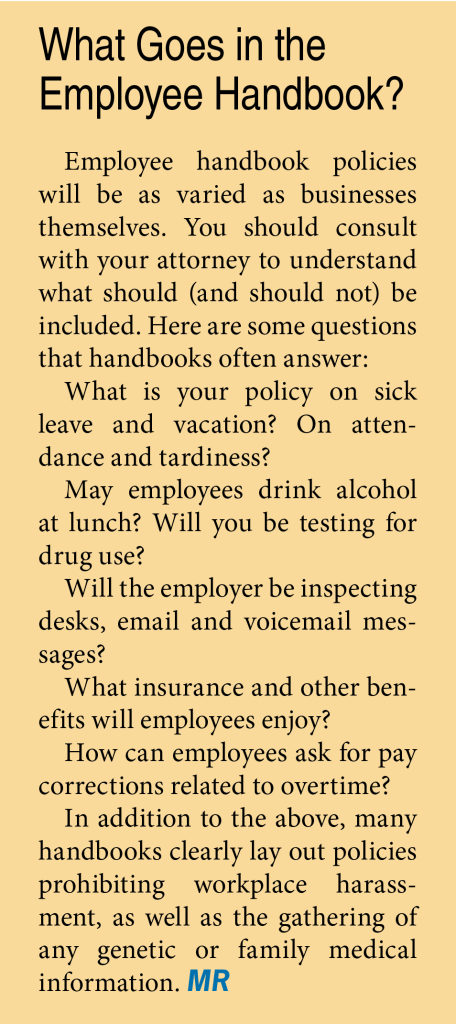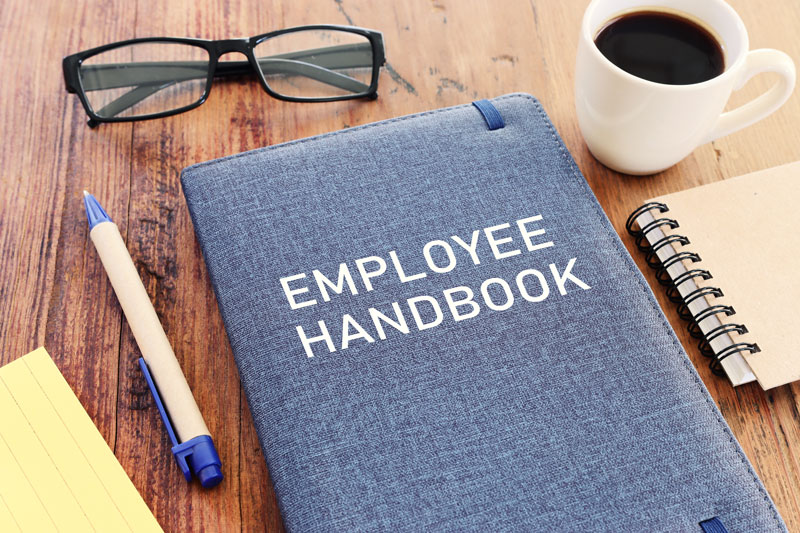By Phillip Perry
What commonly neglected business tool can help your workplace run more smoothly, orient new employees quickly, and reduce your risk of costly legal battles? If you guessed “the employee handbook,” you’re right. Too often given short shrift, this vital document can play a vital role by communicating workplace policies and employee responsibilities. The result can be a more productive organization and a more profitable business.
“Employee handbooks are extremely important for businesses of all sizes,” says James W. Potts, J.D., Chief Executive Officer of the Pasadena, California,-based human resources consulting firm of Potts and Associates (pottsandassociates.com). “They can help everyone work more efficiently.”
The same handbooks that help veteran workers understand your business policies can be especially valuable for recruits. “Giving your handbook to selected applicants can be beneficial in landing the best employees,” says Richard Avdoian, an employee development consultant in Metropolitan St. Louis (MidwestBusinessInstitute.com). “Many times the ideal candidate has multiple offers, and your handbook can tip the balance in your favor by communicating the benefits of joining your team.”
The employee handbook, along with the job description, can set the framework for inducting new people into your business, adds Avdoian. “It communicates the company mission, states expectations and outlines benefits. And it sets the tone for a cooperative ‘we’ culture.”
Once aboard, the new employee should receive a handbook as part of a thoughtful orientation. “The new employee should be given a tour of departments and be introduced to their managers,” says Avdoian. “This communicates idea that each individual is part of a larger organization and is equally important in the success of the company.”
There’s one more benefit of a well-written handbook: reduced legal risk. Suppose, for example, one of your customers is harmed by an employee impaired by alcohol or drugs. Having a record of an anti-drug policy can help mitigate liability. “When you get sued, the first question an attorney will ask is ‘Did you have a policy covering this?’” says Bob Gregg, co-chair of the employment practice law group at Boardman and Clark LLC, Madison, Wisconsin (boardmanclark.com).
At smaller businesses, where supervisors have limited time to communicate all the vital information employees need, handbooks can help fill the gap. At the same time, they communicate a valuable business image. “Like a website, an employee handbook is an expected part of today’s business operation,” says Avdoian. “It tells everyone you are serious about your organization.”
Cover These Topics
The employee handbook is not a “one size fits all” affair. Every organization has its own requirements, and only your attorney can tell you what you should include (and omit) to be in compliance with the law. Nevertheless, there are some topics common to many handbooks. For a rundown, see the sidebar, “What Goes in the Employee Handbook?”
Here are some remarks about the more sensitive topics:
• Email. Even if allowed to use personal devices for business purposes, employees have no right to privacy regarding any business emails that go through those devices, or any personal emails that go through the business system.
“Your policy should state that your business owns all emails that go over your business system, even personal ones,” says Gregg. “Employees should not use the system for anything they do not want company management to see. They should also be informed that even if they hit the delete key the emails will be retained on the company hard drive or in the cloud.”
• Overtime. The 2004 revisions to the Fair Labor Standards Act created a “safe harbor” from liability for unpaid overtime when employers have adequate policies granting employees the opportunity to request wage corrections. “If you do not have such a policy employees can sue you for unpaid overtime without telling you first,” says Gregg. “On the other hand, if you have a clear, correctly worded policy, you can win the case.”
• Privacy statement. “Include a statement of your right to inspect computers, desks, and telephones,” advises Gregg. “If you don’t have it you can be sued for invasion of privacy for looking through what you considered company property.”
• Compliance with the Genetic Information Nondiscrimination Act (GINA). State that your business will not collect any genetic or family medical history information from employees. This will give your organization a “safe harbor” against a lawsuit for discrimination based on such knowledge.

“You should also tell medical providers you do not want information about your employee’s family medical history,” says Gregg. When communicating with your business about medical topics, the providers should use general language. For example, the physician might state “Mary has a serious medical condition” rather than “Mary is absent for a heart condition that is common to her family.”
What to Omit
Handbooks can be a two-edged sword. While they can help protect you from charges of discrimination or other illegal personnel acts, they can also create legal problems of their own. “Handbooks can be dangerous if you don’t know what you are doing,” cautions Gregg. He gives one example: Including poorly written statements in your handbook can affect the “employment at will” status normally enjoyed by businesses. “It’s easy to fall into the trap of creating a contract of employment.”
For example, you may be tempted to include morale-boosting statements such as “You will always be treated fairly here” or “We know you will enjoy your long-term employment” or “Our policy is to promote from within.” These can end up coming back to haunt you later when disgruntled worker sues for a perceived violation of promises that he or she considers contractual.
There’s more. “Avoid falling into the trap of including policies that are not required by law,” says Gregg. “Suppose, for example, your business has only 30 employees. You are not required to comply with the Federal Family and Medical Leave Act (FMLA), which only applies to businesses with 50 or more employees. Including a page about compliance with the FMLA can create a condition in which you are covered by that law even if you normally would not be.”
And watch out for seemingly innocuous requirements that can land a business in hot water. “Some policies that seem good on their surface can violate federal, state or local laws,” says Potts. “For example, an employer might state that departing employees must turn in company property such as cell phones or laptops before a final check is cut. That can be illegal in some states.” Employers with operations in more than one state face special hurdles, he adds. “A policy that is legal in one state may violate the law in another.”
In a related area, be aware of city and state laws and regulations that can require you to follow specific policies and prohibit others. “Many cities have laws covering such areas as family and sick leave,” says Beth Brascugli De Lima, president and principal of HRM Consulting, Inc., Murphys, California (hrmconsulting.com). “We are seeing this trend grow very quickly, especially in the larger urban areas.”
Some policies are best left out of the manual altogether. Suppose an employee will be late coming to work. Whom should they call? And how far in advance? These are specifics that you might want to communicate orally, to avoid tying down your operations to procedures you might want to change later in response to changing conditions.
That last point suggests a larger issue: A handbook can end up creating too many restrictions for the business. Indeed, that is precisely the reason why some companies eye them with suspicion. “Many employers fear getting locked in to the handbook’s wording,” says Potts. “But that problem can be avoided if the handbook is written correctly.”
As the above comments suggest, writing an employee handbook can be a challenging task. “It’s a mistake to try to write the handout on your own,” says Avdoian. “If you haven’t a human resources professional on your staff you need to consult an HR expert and make sure an attorney reviews the document so you are in compliance with federal, state and local laws.”
All Aboard
The employee handbook does not have to be a big glossy production. It can be as simple as a half-inch thick three-ring binder of pages covering the core issues. But once that document is completed, make sure everyone reads it and signs a document stating so. Then make sure everyone understands the policies must be followed consistently.
“The most common mistake is creating an employee handbook and then not following it,” says De Lima. “Often this is because supervisors are not well trained and do not understand the importance of consistency.”
The result, says De Lima, can be a costly lawsuit. “Suppose Employee A is treated one way when violating a policy and Employee B is treated another way,” she says. “If Employee B is a protected class under equal opportunity laws, he or she may have a cause for action.” Laws on the federal level, and often on the state and local levels, prohibit discrimination by such characteristics as race, religion, sex, and national origin.
Smart Roll Out
Has your business operated for years without any handbook at all? If so, introducing a new one can create a morale issue when employees feel as though they are being force-fed a whole new slew of workplace rules. To avoid this, introduce the handbook as a tool for enhancing the working environment. “I would introduce a new employee handbook as part of a morale-boosting celebration of the progress being made by the business,” says Avdoian. He suggests distributing the handbook at a company luncheon, for example, using words such as these:
“Thanks to everyone in this room we have grown to the point where we can further fine tune our business. We are now distributing an employee handbook. Most of you already know about our benefits, but perhaps you have forgotten some of them. This handbook includes all of them in one place and outlines the company’s expectations for the future.”
Update Regularly
Researched, written, published, distributed, and signed off on. Once you have completed the employee handbook cycle you have positioned your business to operate more efficiently and profitably. But the handbook is not a “set it and forget it” affair. Laws, regulations, and workplace conditions undergo constant change. Keep asking this question: Does our handbook wording need to be altered to reflect new realities?
“It’s critical to review your handbook on a regular basis,” advises Gregg. Add policies that reflect new challenges and opportunities. And toss those no longer valid. “Clean out your policies like you would old clothes from your closet,” he says. “Handbooks should not be designed by hoarders.” MR

Sign Up For A Free Subscription
Anyone who is involved in the construction trade is welcome to sign up for a free print or digital subscription to Metal Roofing Magazine, which has been advancing the metal roofing industry since 2001. This go-to resource for metal roofing professionals is published 7 times per year.
























